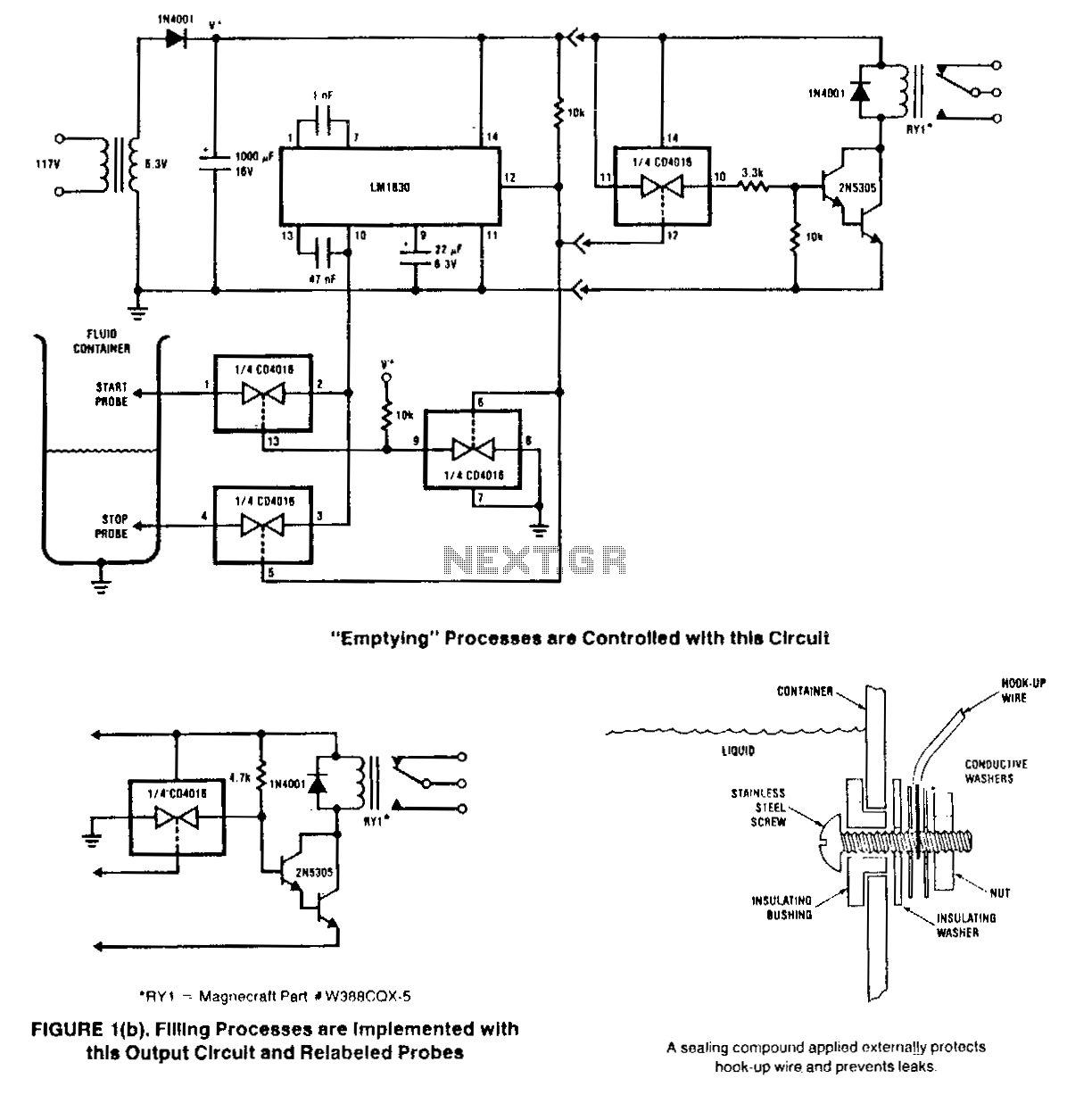
Fluid-level-control

This circuit is designed to detect the presence or absence of aqueous fluids. An AC signal generated on-chip is passed through two probes within the fluid. A detector determines the presence of the fluid by using the probes in a voltage divider circuit and measuring the signal level across the probes. An AC signal is used to prevent plating or corrosion of the probes, which can occur when a DC signal is utilized. Additionally, a pin is available for connecting an external resistor in cases where the fluid impedance is not compatible with the internal 13 kΩ divider resistance.
The circuit operates by generating an alternating current (AC) signal that is introduced through two probes immersed in the fluid being tested. The probes function as part of a voltage divider circuit. When the fluid is present between the probes, it alters the impedance of the circuit, resulting in a measurable change in the voltage across the probes. This voltage change is detected by the circuit, indicating the presence of the fluid.
The use of an AC signal is critical in this design as it mitigates the risks of electrolysis and corrosion that can occur with direct current (DC) signals. Electrolysis can lead to the degradation of the probes, affecting their performance and lifespan. The alternating nature of the AC signal helps to maintain the integrity of the probes by reversing the polarity, which minimizes wear and buildup of material on the probe surfaces.
In addition to the primary detection mechanism, the circuit includes a provision for an external resistor. This feature is particularly useful in scenarios where the impedance of the fluid being tested does not match the internal resistance of the voltage divider (13 kΩ). By allowing for an external resistor to be connected, the circuit can be adjusted to accommodate a wider range of fluid types and conditions, ensuring reliable operation across different applications.
Overall, this circuit's design is focused on providing accurate fluid detection while maintaining the durability of the probes and offering flexibility to adapt to various fluid characteristics.This circuit is designed to detect the presence or absence of aqueous fluids. An ac signal generated on-chip is passed through two probes within the fluid. A detector determines the presence of the fluid by using the probes in a voltage divider circuit and measuring the signal level across the probes. An ac signal is used to prevent plating orills solving of the probes as occurs when a de signal is used.
A pin is available for connecting an external resistance in cases where the fluid impedance is not compatible with the internal 13Kohm divider resistance. 🔗 External reference
The circuit operates by generating an alternating current (AC) signal that is introduced through two probes immersed in the fluid being tested. The probes function as part of a voltage divider circuit. When the fluid is present between the probes, it alters the impedance of the circuit, resulting in a measurable change in the voltage across the probes. This voltage change is detected by the circuit, indicating the presence of the fluid.
The use of an AC signal is critical in this design as it mitigates the risks of electrolysis and corrosion that can occur with direct current (DC) signals. Electrolysis can lead to the degradation of the probes, affecting their performance and lifespan. The alternating nature of the AC signal helps to maintain the integrity of the probes by reversing the polarity, which minimizes wear and buildup of material on the probe surfaces.
In addition to the primary detection mechanism, the circuit includes a provision for an external resistor. This feature is particularly useful in scenarios where the impedance of the fluid being tested does not match the internal resistance of the voltage divider (13 kΩ). By allowing for an external resistor to be connected, the circuit can be adjusted to accommodate a wider range of fluid types and conditions, ensuring reliable operation across different applications.
Overall, this circuit's design is focused on providing accurate fluid detection while maintaining the durability of the probes and offering flexibility to adapt to various fluid characteristics.This circuit is designed to detect the presence or absence of aqueous fluids. An ac signal generated on-chip is passed through two probes within the fluid. A detector determines the presence of the fluid by using the probes in a voltage divider circuit and measuring the signal level across the probes. An ac signal is used to prevent plating orills solving of the probes as occurs when a de signal is used.
A pin is available for connecting an external resistance in cases where the fluid impedance is not compatible with the internal 13Kohm divider resistance. 🔗 External reference